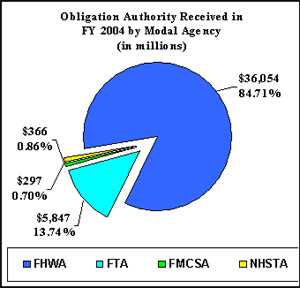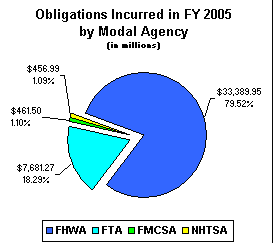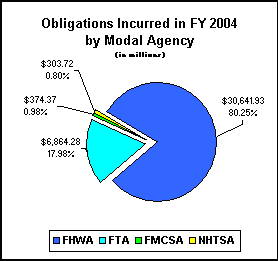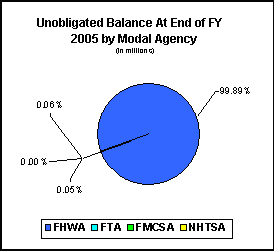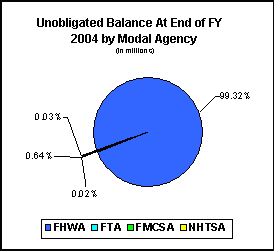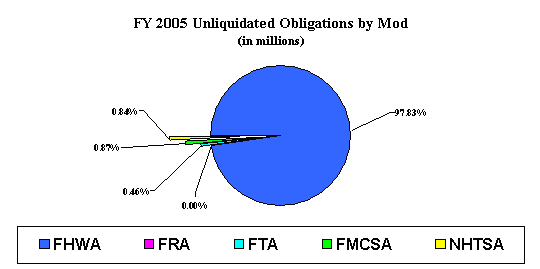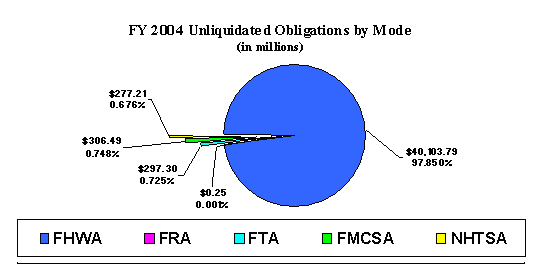Appendix B
FMCSA
FMCSA continues to maintain a high standard of excellence with regard to its financial processing and reporting which is performed by the FAA's Enterprise Service Center in Oklahoma City, OK. FAA has brought positive recognition to FMCSA for its improved development and implementation of financial reporting processes, procedures, and documentation. FMCSA continues to refine business tools to promote fiscal discipline, reliability, and accountability. These actions continue to enable FMCSA to meet accelerated OMB deadlines for the receipt of financial statements.
The following table depicts the performance measures and goals for Financial Stewardship. FHWA and FTA each had a part to improve the financial management and project management of mega-projects (projects with costs over $1 billion) identified as the first two measures.
| FINANCIAL STEWARDSHIP - Departmental Performance Measures and Goals | ||||||
|---|---|---|---|---|---|---|
| Performance Measures | Modal Administration | FY 2002 Actual |
FY 2003 Actual |
FY 2004 Actual |
FY 2005 Actual |
|
| For major federally-funded infrastructure projects, percentage that meet schedule milestones established in project or contract agreements, or miss them by less than 10 percent. | FHWA, FTA | 85 Target 95 |
88 Target 95 |
74 Target 95 |
87.5 Target 95 |
|
| For major federally-funded infrastructure projects, percentage that meet cost estimates established in project or contract agreements, or miss them by less than 10 percent. | FHWA, FTA | 85 Target 95 |
88 Target 95 |
95 Target 95 |
75 Target 95 |
|
| Percentage of transit grants obligated within 60 days after submission of a completed application. | FTA | 67 Target 60 |
83 Target 80 |
91 Target 80 |
91* Target 80 |
|
*Preliminary estimate
FY 2005 Results: The Department did not meet its target to achieve 95 percent of schedule milestones for major federally-funded transportation infrastructure projects, or missed those milestones by less than 10 percent. There were a total of 16 projects (4 in FTA and 12 in FHWA) that met the definition of major transportation infrastructure projects. In FY 2005, 14 of 16 projects (3 in FTA and 11 in FHWA) met milestones or missed them by less than 10 percent.
The Department met its transit grant obligation timeliness target.
The IG has stated that the Department's ability to achieve its strategic goals of increased mobility, improved safety, and sustained economic growth undoubtedly will be challenged in the face of an unprecedented federal deficit of about $374 billion. Aggressive oversight is needed to ensure that the over $37 billion annual federal investment in highway and transit projects is well managed and protected from fraud. Improvements to project oversight and efficiency can have major results. The Department must also ensure that all tax dollars due to the HTF are received.
FHWA
FHWA issued guidance defining the content and format of the Financial Plans for major projects, which are generally defined as projects at the $1 billion dollar and larger level. A Financial Plan provides a comprehensive view of the total cost of the project and reasonable assurances that there will be sufficient financial resources to complete the project as planned. Cost containment strategies are also identified in the Financial Plan, as well as an implementation schedule for completing the project. FHWA requires annual updates to track significant cost and schedule deviations from the initial Financial Plan, and mitigating actions taken to adjust for those deviations. FHWA reviewed major projects reports on cost, schedule, and status. Periodic status meetings were also held with the STA project management team, FHWA, and other involved agencies in attendance. These periodic status meetings discussed project costs, schedules, quality issues, and other status items in sufficient enough detail to allow involved parties to be aware of significant issues and take actions planned to mitigate any adverse impacts.
Both the GAO and the OIG raised additional concerns about Agency oversight of cost and schedule issues on projects funded with federal-aid funds. To address some of these continuing concerns and lay the groundwork for building a new Project Management Tracking System, the Agency initiated an effort to develop a more formal, documented approach to project delivery oversight.
A Program Risk Management Pilot Program was established, with seven Division offices participating, to test a risk management framework for its viability and sustainability. A risk management expert was retained to provide assistance with the development of the management framework and assist Agency staff during the implementation of the pilot program. The input from the participating offices will allow the Agency to fully implement a Risk Management Program in FY 2006.
As part of its efforts to support effective program management, the Transportation Infrastructure Finance and Innovation Act (TIFIA) credit program developed formal guidance for Project Oversight and Credit Monitoring. The guidance is intended to assist the Department and its modal agencies in carrying out oversight responsibilities for TIFIA-funded projects by providing a consistent approach to monitoring projects through a project's life cycle.
The following activities contributed to FTA's success in meeting the performance targets for the infrastructure projects.
FTA initiated a risk management program for its major capital projects. FTA's risk management is a continuous process that includes a formal planning activity, assessment activities (identification and analysis) to estimate the likelihood and predict the impact on the project, a mitigation strategy for selected risks, and monitoring the progress in reducing the selected risks to the desired level. The risk assessment for project cost and schedule is performed by FTA's Project Management Oversight (PMO) contractor and identifies and ranks the highest areas of risk. The report is then used as a guide to establish a risk mitigation plan with which to monitor risk through the completion of the project. This risk management program creates a confidence level for the project budget and schedule, and enables FTA and the grantee to proactively manage the project.
As of September 30, 2005, 91 percent of the 2,047 grants processed were obligated in 60 days or less, beating the goal of 80 percent processed in 60 days or less. The amount of time to process grants was reduced from an average of 67 days in 2001 to just 28 days in 2005 FTA accomplished several key activities to improve grant processing time. This included making improvements to the Transportation Electronic Award and Management (TEAM) system used to make grants, an expedited notification of certification by DOL, and faster start up of the grant process at the beginning of the fiscal year. FTA worked with DOL to develop a procedure for certifying grants in advance for the scope of the full funding anticipated in FY 2005 rather than certifying each grant amendment adding incremental funding. Additionally, FTA resolved mid-year problems with electronic notification to DOL resulting from new computer security firewall protections, and opened TEAM for obligation earlier in FY 2005 as a result of monthly reconciliation of TEAM data during FY 2004.
The federal government can secure better services at lower cost through E-Gov, and can meet high public demand for E-Gov services. This Administration's goal is to champion citizen-centered E-Gov that will result in a major improvement in the federal government's value to its citizens.
FHWA successfully migrated from the Department legacy personnel and payroll system to the Federal Personnel and Payroll System (FPPS), as part of the e-payroll initiative under the PMA. FHWA played a leadership role on the Departmental FPPS Steering Committee as the sole representative and primary source of information for the smaller Operating Administrations (OA). The migration was successful; 100 percent of staff were paid during the first pay period of implementation.
OMB issued requirements that each Agency implement E-Authentication for at least one public facing system in FY 2006. With the execution of a Memorandum of Understanding between the Department and General Services Administration (GSA) in 2005, FHWA became the Departmental representative in this effort.
All of FHWA Business Cases (Exhibits 300) for major IT investments for FY 2006 and FY 2007 passed OMB examination on the first round. Also, FHWA completed an E-Gov Strategy Review for all major IT investments. The Agency led the first Department Commodity Council in the new IT Products and Services Department Enterprise Architecture (EA) Inclusion Process.
FTA
In FY 2005, FTA strengthened computer security and investment controls through the implementation of an additional tracking application for grantee oversight and the relocation of the disaster recovery site to Kansas City, MO. The Department-wide IT consolidation scheduled for FY 2006 will further impact FTA's business controls and processes..
FTA continues to participate in the Departmental initiative to consolidate grant systems within the Department. The approach currently under consideration is being revised to reduce Departmental systems from eight to three in an effort to comply with legislative requirements of the new SAFETEA-LU reauthorization. This activity is in support of the federal Grants.gov initiative to make identifying and applying for federal grants much easier for the public.
NHTSA
NHTSA continued to participate actively in many of the government-wide E-Government initiatives, such as e-Payroll, e-Training, e-Travel, Integrated Acquisition Environment, and others. In addition to these measures to increase internal efficiency and effectiveness, NHTSA pursued measures to improve services externally:
- through NHTSA's participation in Grants.Gov, 100% of all discretionary competitive grants are advertised on Grants.Gov and may be applied for electronically through Grants.Gov
- through NHTSA's participation in Business Gateway, information and forms for auto importation are now available on www.business.gov
- through NHTSA's participation in USA Services, the new contract for the Auto Safety Hotline provides improved service to the public when they ask for vehicle and traffic safety information.
NHTSA has contributed to the DOT "Green" score in E-Gov, by providing acceptable business cases and effective management, demonstrated through quarterly Earned Value Management measures, for all of its major IT initiatives. 100% of all NHTSA's IT systems are properly secured, certified and accredited.
FMCSA
In FY 2005, FMCSA's accomplishments with regard to E-Gov include:
- Performed security re-certification and re-accreditation of FMCSA IT systems.
- Established a new "change governance structure" to review and implement changes to FMCSA's systems.
- Implemented Earned Value Management and Reporting for FMCSA's major IT initiatives.
- Established an executive level governance board to ensure that the systems directly support high-priority agency goals and mission.
- Revised the capital planning process to incorporate the new executive governance and change management structure.
- Provided technical support to the public as E-Gov is expanded.
- Enhanced organizational productivity by providing reliable access to the IT infrastructure.
- Met the administrative and IT service needs of program delivery in accordance with workload indices and performance measures.
- Provided access to FMCSA registration and licensing forms through the business gateway Web portal
- Implemented changes to processes, methods, tools, service level agreements and organizational alignment across the IT organization to reflect recommended improvements derived during the independent program assessments conducted in late FY 2004.
- Partnered with the e-authentication initiative and pilot security capabilities.
- Provided access to States to apply for grants through the Grants.gov Web portal.
RITA
RITA completed the Certification and Accreditation (C&A) of all major IT systems and began the process of training IT project managers on C&A requirements.
Budget and Performance Integration
FHWA
FTA
FTA made progress in two areas that will increase its effectiveness. In FY 2005 FTA identified performance measures and key outcomes for its major programs and tracked progress monthly through a new "Transit Trends" report. This report was provided to FTA's Executive Management Team to make business decisions.
FTA made significant progress in FY 2005 in the implementation of a managerial cost accounting system that will satisfy mandatory managerial and legal requirements and will improve FTA's cost assignment efforts. FTA expects to implement managerial cost accounting during FY 2006.
FTA also completed an assessment of its Formula Grant program using the Office of Management and Budget's Program Assessment Rating Tool (PART). FTA received a PART score of 92 (out of 100), completed as part of the FY 2006 Budget. The results of the PART demonstrate that the Formula Grant program is effective in increasing ridership and improving the condition of transit assets and accessibility to public transportation for physically challenged individuals.
NHTSA
NHTSA continued to revise its performance appraisal system to link the Administrator's Accountability Agreement to performance agreements with the agency's Senior Associate Administrators (SAA). These agreements reflect their contributions to NHTSA's performance goals, which cascade down to negotiated goals with the Associate Administrators (AA). In addition, Office Directors' and Division Chiefs' agreements align with these negotiated goals and staff performance appraisals were amended to reflect individual contributions to the agency's common mission. As part of submitting the FY 2007 Budget, NHTSA continued to provide marginal cost of performance information for new safety initiatives. This activity is part of the Department's implementation of cost accounting Agency-wide. For the PART, the agency continued to implement OMB recommendations from its 2004 Grants and 2006 Operations and Research assessments.
FMCSA
In FY 2005, FMCSA's accomplishments with regard to Budget and Performance integration include:
- Conducted regular meetings of senior agency managers, capped by an annual budget retreat meeting, where managers examine reports that integrate financial and performance information and use this information to make decisions regarding the management of Agency programs.
- Continued efforts to expand and refine outcome-oriented goals and objectives and ensure that annual budget and performance documents incorporate all measures identified in the PART and focus on the information used by senior managers.
- Increased the number of performance appraisal plans that link to Agency mission, goals, and outcomes; effectively differentiate between various levels of performance; and provide consequences based on performance.
- Reported the full cost of achieving performance goals accurately in budget and performance documents and can accurately estimate the marginal cost of changing performance goals.
- Continued to develop and refine an efficiency measure for all programs; and use PART evaluations to direct program improvements and to justify funding requests, management actions, and legislative proposals.
MANAGEMENT CONTROLS AND COMPLIANCE WITH LAWS AND REGULATIONS
Management Controls
Federal Managers Financial Integrity Act (FMFIA)
The objectives of Section 2 and Section 4 (internal controls and financial accounting systems respectively) of the FMFIA of 1982 are in the process of being met by the HTF modes in FY 2004. All departmental organizations are subject to Sections 2 and 4 of the FMFIA.
For FY 2004, HTF had four material weaknesses. Two were related to Section 2 and two were associated with Section 4. The four material weaknesses open during FY 2004 that impact the HTF are:
- The Department's information systems security
- The Department's intragovernmental account balances
- FTA controls over financial operations
- FHWA's controls over financial operations.
Identified below are the actions each mode has taken to correct the material weaknesses identified.
The Department's Information Systems Security
FHWA
During FY 2005, FHWA continued to work on the reduction of security weaknesses and reported its progress through the quarterly Plan of Action and Milestones Departmental update process. FHWA continued to operate its vulnerability scanning program which requires that all remediation of vulnerabilities must be done before new servers are attached to the network. FHWA also conducted yearly security reviews on all its systems and performed yearly updates on all Security Plans which included a review of the level of risk. FHWA assessed the sensitivity of its systems using FIPS 199. Finally, FHWA continued its security patching efforts and performs routine patch scans to ensure that patches are applied.
FMCSA
Consistent with OST's guidance, FMCSA developed IT security plans for all of its 19 systems and completed C&A for 100 percent of its systems by June 30, 2004.
FTA converted the ECHO front-end module to a web-based platform (ECHO-web) in October 2004 and the Treasury Electronic Certification System (ECS) to the Treasury Secure Payment System (SPS) web-based environment in August 2005. The ECHO database processor is also scheduled for migration to an Oracle platform during the 1st quarter of FY2006. These initiatives will ensure that the systems application and controls are operating in a more secure and compliant environment.
NHTSA
NHTSA met the requirements of the Federal Information Security Management Act by accomplishing 100 percent C&A of its IT systems and a reduction of high-risk vulnerabilities to zero in a timely fashion. NHTSA participated in the development of the Department's Enterprise "Target" architecture and modernization blueprint.
FHWA
FHWA continued to identify and reconcile all trading partners, including fund balances with all entities. This effort will likely be completed during FY 2005. As part of its corrective actions, FHWA, with contractor assistance, began preparing a policy and supporting procedures to document the process for reimbursable agreements (RA) from cradle (preparing and obtaining approval) to grave (RA closeout) to ensure better accountability and reporting. This will include approval of RAs, procedures for maintaining RA information and special coding practices to more easily identify RAs in the accounting system. These procedures will ensure more accurate reporting of eliminations on the HTF financial statement. FHWA anticipates completing this initiative in FY 2005.
FMCSA
FMCSA maintained a log of all reimbursable and interagency agreements and actively interacted with applicable trading partners to ensure accurate recording of these agreements. FMCSA began the process of developing and implementing an improved numbering mechanism to more easily identify agreements as either payables or receivables.
NHTSA
NHTSA worked with FAA's Enterprise Service Center plus participated in intra-modal meetings to identify and track its intragovernmental transactions and trading partners. NHTSA has assigned an individual with responsibility to maintain detailed information for all reimbursable agreements (RA), including quarterly reconciliations of RA activity to the financial information in the accounting system. Through these efforts, NHTSA has made significant progress toward completing this reconciliation and has completed the identification of all trading partners for intragovernmental reimbursable activity. NHTSA has adopted and documented standardized reimbursable activity policy and procedures to insure timely and correct reporting of all RA activity.
FTA Controls Over Financial Operations
FHWA Controls Over Financial Operations
FHWA developed and implemented new accounting policies and procedures, including policies/procedures on financial statement preparation; journal voucher management; preparation of grant accruals; suspense processing; preparation of Accounts Payable and HTF estimates; and reconciliation procedures for grant transactions, fund balance with Treasury, and payroll. These policies and procedures have been instrumental in the enhancing the quality and timely preparation of the FY 2004 financial statements. FHWA has identified a number of other policies and procedures that will be developed in FY 2005, e.g., RAs, Transportation Infrastructure Finance and Innovation Act (TIFIA) loans, SF-133 (Standard Form) preparation and reconciliation, etc.
FHWA contracted out its reconciliation processes to a commercial accounting firm. This firm was required to catch up reconciliations from October 2003 to June 2004. This included monthly reconciliations of SF-224 transactions and Statement of Differences and cumulative grant transactions (obligations and expenditures) in the corporate accounting and grant systems on a daily and monthly basis. The June 30, 2004 financial statements were the first statements produced by FHWA that were reconciled. FHWA also completed the reconciliation of over 3,700 highway projects where balances between the accounting and grant systems did not agree.
In FY 2004, FHWA also implemented a number of system controls to improve financial accountability. FHWA began controlling annual funding allocations at the allotment level to eliminate overspending. FHWA also enhanced its grant system to not allow states to de-obligate more funds than were available for such purposes. FHWA implemented other policies and procedures to ensure that all payments made were done so with sufficient funds existing in the accounting system prior to payment.
Finally, FHWA researched and resolved approximately $2.2 billion in transactions that were deposited into suspense accounts dating back to 1992.
Improper Payments Information Act
In the first year of implementation of the Improper Payments Information Act (IPIA) of 2002, the Department conducted a review of the majority of its programs and activities to identify those that may be susceptible to significant improper payments. OMB has defined significant as 2.5 percent of payments or $10 million. This improper payments risk assessment was conducted in two phases. For the first phase, the Department engaged KPMG, LLP to research and develop an improper payment risk assessment process and methodology. Based on this methodology, the following programs funded from the HTF were selected for testing in FY 2004:
- Federal Highway Administration (FHWA) - Federal Aid Grant Program1
- FHWA - Federal Lands
- Federal Transit Administration (FTA) - Formula Grant Program1
- FTA - Capital Investment Grant Program1
No questionable payments were found during the review, OAs provided adequate supporting documentation for all sample items. Accordingly, AOC classified all sampled items as either proper or improper.
The review results show that for the 4 programs listed above individually and taken as a whole, the HTF does not have improper payments that exceed both 2.5% of program payments and $10 million.
Test procedures applied during the review covered payments made to grantee entities under the Federal Highway Administration Federal Aid Program, and the Federal Transit Administration Formula Grant and Capital Investment Grant Programs. However, test procedures did not address subsequent flow down payments made by grantees to vendors. States and other non-Federal entities administer these grant programs and, accordingly, much of the activity subject to testing for improper payments is accounted for at these entities. HTF does not have records of grantee-level payment activities available for testing. Therefore, test procedures used for this review did not cover these activities.
To address the foregoing limitation, HTF devised an innovative research and development (R&D) strategy that was implemented at the Federal Highway Administration's Highway and Construction (Federal Aid) grant program. This strategy involved using a proof of concept research project to develop and test a methodology to satisfy the testing, estimation, and remediation requirements of IPIA for grant programs, particularly those involving construction projects. HTF completed the project successfully in the summer of 2005 and is in the process of extending the methodology nationwide. The results of this project are provided in a separate report.
To address the limitations in non-construction programs, HTF is currently working with the Federal Transit Administration to expand existing oversight programs to meet IPIA requirements. DOT anticipates completing this process in FY 2006 for full implementation in FY 2007.
Compliance With Laws and Regulations
The audit of the FY 2005 HTF financial statements identified non-compliances with laws and regulations. Below are actions taken by affected HTF modal administrations to correct these instances of non-compliance.
Federal Managers Financial Integrity Act (FMFIA) of 1982
To strengthen the grants management program, FHWA developed a policy and review program for the Division offices that includes toolkits for required reviews to ensure consistency of application across offices. The policy requires annual conduct of a risk assessment of state billing processes. Based on the risk assessment, the Division office is required to perform a process review of the highest rated area. Division offices must also perform periodic reviews of sample state billings to ensure proper documentation; annual reviews of inactive project obligations with outstanding balances of over $500,000; sample testing of administrative financial processes and controls (e.g., credit card purchases, convenience checks, travel vouchers, etc.); and timely follow up on all audit findings applicable to FHWA programs. As part of the annual Section 2/4 certification, each Division Administrator must identify all actions taken and the results of those actions to support his/her certification and assurance statement. FHWA intends to implement this policy in FY 2005. enhanced training to provide an understanding of revisions to A-123 and NHTSA's MCP, forming of MCR teams with knowledgeable individuals of the their program area, and analytical skills to conduct MCR; and conducting rigorous testing using by incorporating the methodology of selecting test methods, quantifying amount of testing, plan data collection, analyze test results, plans for corrective action, and report the results. NHTSA next steps are to present the MCP to senior management to achieve buy-in early June; launch the MCP website, provide training and conduct Management Control Assessment.
Federal Financial Management Improvement Act (FFMIA)
The Department's FY 2001, 2002, 2003, and 2004 Consolidated Financial Statements received unqualified audit opinions from the Department's OIG. However, the OIG determined that the Department was not in full compliance with the FFMIA because material weaknesses existed for the Department's financial, accounting, and information security programs.
FFMIA builds on the foundation laid by the Chief Financial Officers (CFO) Act of 1990 by emphasizing the need for agencies to have financial management systems that can generate timely, accurate, and useful information with which to make informed decisions and to ensure accountability on an ongoing basis. Full compliance with FFMIA hinges on the continued success of implementing Delphi throughout the Department.
Identified below are the actions each mode has taken to correct the material weaknesses identified.
FHWA
FHWA developed and implemented new accounting policies and procedures on recording and reconciliation of financial transactions. FHWA also established reconciliation processes to ensure data in the grant system agreed with data in the financial management system. Finally, FHWA began work to develop procedures to identify and reconcile all intra- and interagency transactions to include specific coding to identify these transactions in the accounting system.
Anti-Deficiency Act
FHWA
The two previous year audit reports identified an anti-deficiency matter whereby DOT improperly expended the Treasury miscellaneous receipts in the amount of $49 million. DOT reported this violation to OMB and Congress in FY 2003. DOT returned $44 million to the Treasury through September 30, 2003. The remaining $5 million is mostly attributed to FHWA's Federal-Air Highway activities. Due to lack of funding, FHWA has not returned the remaining $5 million to the Treasury as of September 30, 2005 and Congress has not provided a waiver for the repayments.
FHWA implemented a number of system controls to improve financial accountability. In the corporate accounting system, beginning with FY 2004, FHWA began controlling annual funding allocations at the allotment level to eliminate overspending. FHWA also enhanced its grant system to not allow states to de-obligate more funds than are available for such purposes. Further, FHWA implemented other policies and procedures to ensure that all payments made were done so with sufficient funds existing in the accounting system before making any payments.
Managerial Cost Accounting and Performance Management
FHWA
FHWA, with contractor assistance, developed an implementation strategy for cost accounting that requires the use of three cost accounting methodologies to cover all agency funding/programs. That strategy was approved by senior FHWA management. FHWA also identified needed requirements and acquired the cost accounting software that will be used for its cost accounting program. Finally, FHWA completed the development of a High Level Design which includes identification of all products and services provided by the Agency and all supporting work activities conducted by employees in support of the products and services (labor distribution). This design was piloted in FY 2005 and then Agency-wide deployment will begin shortly thereafter.
FTA
In response to a President's Management Agenda item, "Budget and Performance Integration" and other federal financial requirements, FTA has been in the process of implementing managerial cost accounting (MCA) throughout the agency since January 2005. The agency contracted with Duncan & Company to aid in the implementation.
Since that time, FTA has made tremendous progress on its MCA implementation. Together with its contractors, it interviewed senior managers form Headquarters and Regional offices to ascertain their current and future costing needs. In addition, an agency-wide survey was sent to all FTA staff to understand the level of knowledge of the staff on the MCA system and their tolerance for change. Approximately 42% of the agency responded. All of these results were used to develop a conceptual model upon which FTA's MCA model is based. In August through September 2005, FTA conducted a pilot of the LDR portion of CASTLE. Beginning in October 2005, FTA will implement MCA throughout the agency on an office-by-office basis. The scheduled completion date is March 2006.
Financial Highlights
The HTF's financial statements, which appear in the Financial Section of this Report, received for the second straight year an unqualified audit opinion issued by the independent accounting firm of Clifton Gunderson, LLP. Preparing these statements is part of the HTF's goal to improve financial management and to provide accurate and reliable information that is useful for assessing performance and allocating resources. Management of each modal administration is responsible for the integrity and objectivity of the financial information presented in the financial statements.
The financial statements and financial data presented in this report have been prepared from the accounting records of the Highway Trust Fund in conformity with accounting principles generally accepted in the United States of America (GAAP). GAAP for Federal entities are the standards prescribed by the Federal Accounting Standards Advisory Board (FASAB).
Overview of Financial Position
Assets. The Consolidated Balance Sheet shows the HTF had total assets of $12.8 billion at the end of FY 2005. This is a decrease of $1.9 billion (13.1%) from the previous year's total assets of $14.7 billion. The decrease is primarily the result of a decrease of $2 billion in Investments.
The HTF's assets reflected in the Consolidated Balance Sheet are summarized in the following table (dollars in thousands):
| 2005 | 2004 | |
|---|---|---|
| Investments | $ 8,270,638 | $10,211,852 |
| Fund Balance with Treasury | 4,217,543 | 4,270,531 |
| Accounts receivable, net | 46,940 | 15,483 |
| Property, plant and Equipment, net | 106,653 | 47,021 |
| Other Assets | 168,020 | 186,272 |
| Total Assets | $12,802,930 | $14,731,159 |
Investments and Fund Balance with Treasury comprise over 97% of total assets for FY's 2005 and 2004. Investments consist entirely of U.S. government Securities held in the HTF Corpus.
Liabilities. The HTF had liabilities of $2.5 billion at the end of FY 2005, which is reported in Consolidated Balance Sheet and summarized in the following table (dollars in thousands):
| 2005 | 2004 | |
|---|---|---|
| Grant Liabilities | $2,274,780 | $2,195,580 |
| Accounts Payable | 46,940 | 147,621 |
| Other Liabilities | 249,782 | 247,385 |
| Total Liabilities | $2,571,502 | $2,590,586 |
The grant liabilities represent an accrual for costs incurred by grantees that have not been reimbursed by the modal administrations.
Ending Net Position. The HTF's Net Position at the end of FY 2005 on the Consolidated Balance Sheet and the Consolidated Statement of changes in Net Position was $10.2 billion, a decrease of $1.9 billion (15.7%) from the previous fiscal year.
Operating Issues in FY 2005. The high gas prices and lack of authorizing legislation have impacted the HTF in FY 2005. The high gas prices lowered revenues deposited to the HTF. The lack of authorizing legislation combined with multiple extensions impacted the modes' ability to issue grants and carry out their functions. The charts below provide a comparison of FY's 2005 and 2004 for selected key financial indicators.
The charts below show the amount and sources of revenues for FYs 2005 and 2004. Revenues increased from $34.7 billion in FY 2004 to $37.9 billion in FY 2005.
As noted on page 3, FRA did not receive any funds in FY 2005. As a result, the following charts do not include any amounts for FRA.
In FY 2005, there was a $3.9 billion increase in obligation authority from FY 2004 (from $42.5 billion to $46.4 billion). The following charts show the authority received by mode. The FHWA amounts include RITA for FY 2005 and BTS for FY 2004.
In FY 2005 obligations incurred were $41.9 billion, $3.7 billion more than in FY 2004. The following charts show the obligations incurred by mode. The FHWA amounts include RITA for FY 2005 and BTS for FY 2004.
The amount available for obligation at yearend increased $3.4 billion from $7.2 billion in FY 2004 to $10.6 billion in FY 2005. The following charts show the amounts available for obligation by mode for each year. The FHWA amounts include RITA for FY 2005 and BTS for FY 2004.
The amount of unliquidated obligations at yearend increased from $40.98 billion in FY 2004 to $42.7 billion in FY 2005, an increase of $1.7 billion. The charts below show the unliquidated obligations by mode. The FHWA amounts include RITA for FY 2005 and BTS for FY 2004.
Limitation of Financial Statements
Management prepares the accompanying financial statements to report the financial position and results of operations for the Highway Trust Fund pursuant to the requirements of Chapter 31 of the United States Code section 3515(b).
While these statements have been prepared from the books and records of the HTF in accordance with the formats prescribed in OMB Bulletin 01-09, Form and Content of Agency Financial Statements, these statements are in addition to the financial reports used to monitor and control the budgetary resources that are prepared from the same books and records.
These statements should be read with the understanding that they are for a component of the U.S. Government, a sovereign entity. One implication of this is that unfunded liabilities reported in the statements cannot be liquidated without the enactment of an appropriation and ongoing operations are subject to the enactment of appropriations.
1In FY 2005 the Bureau of Transportation statistics was merged into the new Research and Innovative Technology Administration.
1The FHWA amount shown includes transfers for RITA.
# Outcomes are specifically related to the HTF modes.
1Identified in the former Section 57 of OMB A-11 as a program that requires reporting of improper payments.




